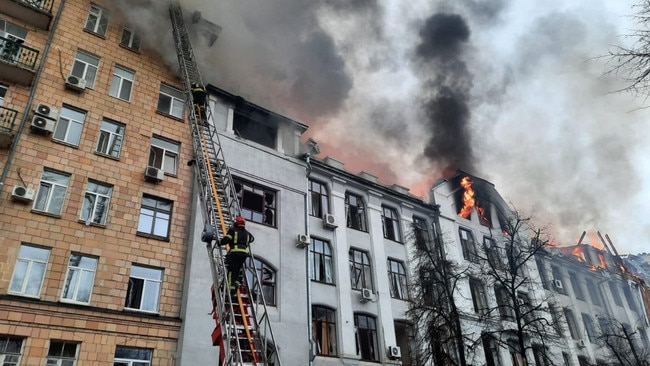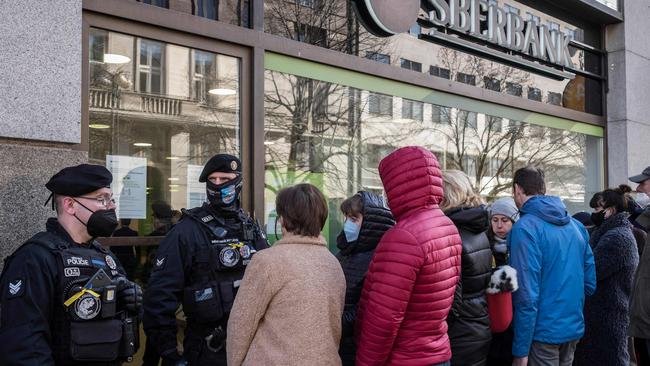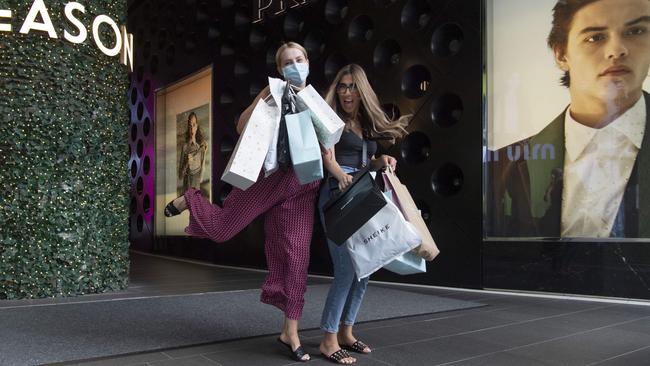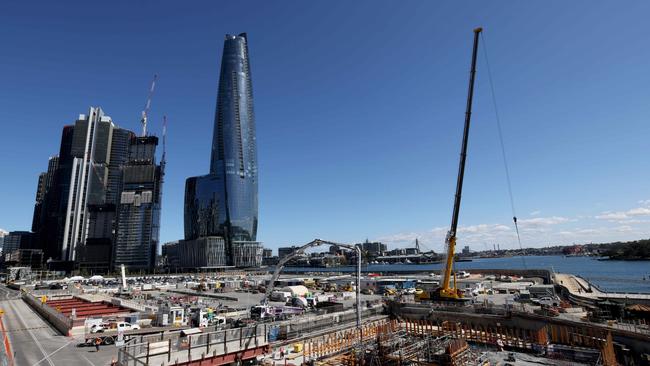Russia swamped by ESG investment forces as Ukraine conflict escalates
Australia’s top super funds are facing calls from members demanding to know what their exposure is and to dump anything linked to Russia.

Business
Don't miss out on the headlines from Business. Followed categories will be added to My News.
The same powerful green investing forces that have driven a dramatic reshaping of financial markets in recent years are now being applied to the Russian-Ukrainian conflict.
ESG investing, which puts demanding standards over environmental, social and governance issues, has a new column: ‘R’ for Russia.
Australia’s biggest super funds have faced calls from members in recent days demanding to know what their exposure to Russia is and to dump anything linked to Moscow following its invasion of Ukraine.
This is being repeated around the world with hundreds of billions of dollars of investments at risk of being sold as fund managers and even companies are coming clean over their Russian exposure.
The move, which stands to choke off access to capital and liquidity, opens a new front in modern conflicts and in some cases can deliver a devastating blow to the Russian economy.
The sell-off is being delivered over and above official sanctions that have been slapped on Moscow, including the freezing of Russia’s $US600bn-plus in foreign reserves. Banks are also cutting back exposure after Russia was cut from the global SWIFT banking network.

British oil giant BP got the ball rolling this week by pledging to sell a $US25bn stake in Russian oil major Rosneft. ExxonMobil will begin a phased withdrawal from the major oil field it operates in Russia, tech giants Apple and Google have vowed to stop selling products in Russia, while dozens of other companies, including stockmarket operator Euronext, have lined up to suspend business or cut ties. Shipping heavyweight Maersk has promised to stop delivering non-essential supplies to Russian ports.
Moscow has responded to the measures by announcing a temporary ban on foreign investors exiting local assets. And with the Russian stockmarket suspending trading it’s not clear how shares can be sold.
Adding further pressure is the prospect that MSCI, which manages the equity indexes used by fund managers to track global shares, may remove Russian listings. This will start a new wave of selling.
Australian investors have a tiny direct exposure to Russia, but they are still being caught up in the global campaign. Fund managers are reviewing their portfolios to find what investments are lurking in the corners and super funds from the $250bn AustralianSuper down are looking to extract positions. For the most part exposure is in the millions of dollars and usually in the form of bonds which are more liquid than infrastructure.
“Super funds need to be asking their fund managers if they have any exposure to Russia,” Wilson Asset Management chair Geoff Wilson old The Australian.
His global fund has no direct holdings, only “minuscule” exposure through its portfolio of companies it invests in.

The Commonwealth Super Corp, which manages super funds on behalf of public servants, on Wednesday said it has 0.2 per cent of its $58bn fund exposed to Russia and Ukraine. Others including Aware Super have 0.1 per cent of their exposure through a global fund manager.
At the top of the week the Future Fund set the tone by pledging to sell down $200m worth of Russian equities, or 0.1 per cent of its portfolio.
One company to come under pressure is ASX-listed Ansell, which has been expanding its manufacturing capacity in Russia in recent years. Although with the bulk of sales around protective clothing and surgical gloves investors will have more tolerance.
The volatility is forcing global fund managers to move to a more conservative footing and this means building up cash.
Wilson Asset Management’s $1bn global fund has shifted to about 7 per cent cash from 5 per cent at the end of January.
“The cash is up from the end of last month as we’ve tried to add a little liquidity given that uncertainty around Ukraine and just as we saw markets adjusting to higher rates,” says WAM’s lead fund manager Catriona Burns. “We will draw that down as we find stock specific opportunities that are just too compelling to not put money into.”
Wilson’s global fund holds about 65 per cent of its portfolio in US-listed stocks and 13 per cent in Europe, 7 per cent UK and 8 per cent in Asia, including Australia.
–
Lockdown economics
Australians spent more on rock lobsters, prawns and ice-cream at the end of last year than they ever have.
Victorians dropped $3.8bn – a record amount on clothes and shoes during the December quarter to bring the wardrobe up to speed from more than a year of on-again, off-again lockdowns. Spending on furniture and rugs across the state surged to $2.37bn – just short of the record spending following the first release from lockdowns a year earlier, ABS figures show.
People across NSW spent more on beer, wine and spirits ($2.7bn) during the last three months of the year as they celebrated the release from Covid restrictions. For the first time quarterly spending on household appliances in NSW cracked the $1bn mark, no doubt on coffee machines and toasters to soak up the booze.

Queenslanders which were more restrained with spending on alcohol $1.2bn down from the September quarter and down from the previous December quarter, but their spending at restaurants and cafes ($3.5bn) returned to pre-Covid levels and was just short of all time high of $3.6bn. Queenslanders also went to town on furniture and household rugs.
Spending by the entire nation on lobsters ($53m) was five times the amount of pre-Covid Christmas spending even as prices have come down. Prawn sales were double from the September quarter to a record $339m and up on the previous Christmas, while ice-cream sales of $709m were up sharply from the previous summer.
Welcome to lockdown economics which is how Australia adjusted to the distortionary effects Covid lockdowns of the September quarter and the return to more normal life through the December quarter – although with some restrictions still in place.
The latest set of national accounts released by the ABS on Wednesday shows on the surface an economy roaring back to life in the final three months of 2021. GDP jumped by 3.4 per cent during the quarter. This more than offset the 1.9 per cent drop in growth during the Delta-hit September quarter.
But they also show a major sugar hit as people emerge from being stuck in their homes for extended period. And policy makers are watching if this is just a temporary surge.
Growth was underpinned by the two big states NSW and Victoria as they emerged from extended lockdowns. Demand has been driven by catch-up spending from consumers.
The rest of the nation found itself mostly in a holding pattern as it looked for momentum coming out of Covid’s Delta wave.
Household savings ratio fell to 13.6 per cent from 19.8 per cent as Australians started spending their cash pile. Even so, savings remains at pre-Covid high, which remains a good signal for retailers in coming months.

NSW recorded the strongest growth, up 6.7 per cent after spending the near entirety of September quarter in lockdown.
This was followed by Victoria at 3.7 per cent. But others barely shifted the dial. Queensland’s growth was zero, South Australia 0.3 per cent, Western Australia just 0.1 per cent while tourism states Tasmania and NT went backwards.
One worrying sign is activity around business, which remains a big growth lever for the economy. The national accounts show business remained cautious in the lead up to Christmas, while the supply chain shocks were starting to take their toll.
Investment activity was surprisingly weak during the quarter. Housing investment fell 2.2 per cent while machinery and equipment expenditure fell 1.5 per cent during the quarter.
Higher prices through the economy were impacting business investment. This will potentially delay the realisation of some investment in 2022 and could make some projects that were planned less viable while construction costs remain elevated.
The Reserve Bank of Australia is holding firm on cash rates, keeping settings at the ultra-low levels of 0.1 per cent. While economists are tipping rates will start rising from the second half of this year, the figures released Wednesday give little indication it needs to rush to tighten.





